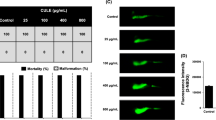Abstract
Citrus species have been used traditionally as a medicinal herb in oriental pharmacology. Here, we reported on the anti-diabetic function of Citrus aurantium L. (CA). The hexane fraction of CA (HFCA) stimulates NCI-H716 cells and results in the secretion of glucagon-like peptide-1 (GLP-1). Because it regulates insulin secretion in pancreatic β-cells, GLP-1 has been used for the treatment of type II diabetes mellitus. Hence, we carried out a series of experiments to demonstrate the functions of HFCA against diabetes mellitus at the molecular level. Four fractions of CA were used in a GLP-1 assay. The GLP-1 ELISA assay was performed to measure the concentrations of GLP-1 after treatment with the four fractions of CA. The hexane fraction showed the best results and was chosen for the microarray analysis in the genome wide analysis. Through the analysis, it was found that voltage-gated potassium (Kv) channels drove membrane depolarization and then influenced Ca2+ currents in NCIH716 cells. These results suggest this is a new oriental herbal drug that has proven effects for the remedy of type II diabetes mellitus.
Similar content being viewed by others
References
Le Neve, B. & Daniel, H. Selected tetrapeptides lead to a GLP-1 release from the human enteroendocrine cell line NCI-H716. Regul. Pept. 167, 14–20 (2011).
Han, X.F., Zhu, Y.L., Hernandez, M., Keating, D.J., & Chen, C. Ghrelin reduces voltage-gated potassium currents in GH3 cells via cyclic GMP pathways. Endocrine 28, 217–224 (2005).
Kim, S.J. et al. Pancreatic beta-cell prosurvival effects of the incretin hormones involve post-translational modification of Kv2.1 delayed rectifier channels. Cell Death Differ. 19, 333–344 (2012).
Jang, H.J. et al. Gut-expressed gustducin and taste receptors regulate secretion of glucagon-like peptide-1. Proc. Natl. Acad. Sci. USA 104, 15069–15074 (2007).
Duez, H., Cariou, B. & Staels, B. DPP-4 inhibitors in the treatment of type 2 diabetes. Biochem. Pharmacol. 83, 823–832 (2012).
Pratley, R.E. & Gilbert, M., Targeting incretins in type 2 diabetes: role of GLP-1 receptor agonists and DPP-4 inhibitors. Rev. Diabet. Stud. 5, 73–94 (2008).
Elashoff, M., Matveyenko, A.V., Gier, B., Elashoff, R. & Butler, P.C. Pancreatitis, pancreatic, and thyroid cancer with glucagon-like peptide-1-based therapies. Gastroenterology 141, 150–156 (2011).
Choi, E.-K. et al. Genome-wide gene expression analysis of Patrinia scabiosaefolia reveals an antibiotic effect. BioChip J. 5, 246–254 (2011).
Kim, K.-S. et al. The multi-target antibiotic efficacy of Angelica dahurica Bentham et Hooker extract exposed to the Escherichia coli O157:H7. 333–342.
Yang, H. et al. Global transcriptome analysis of the E. coli O157 response to Agrimonia pilosa extract. Mol. Cell. Toxicol. 7, 299–310 (2011).
Kim, K.-S. et al. Global transcriptome analysis of the Escherichia coli O157 response to Houttuynia Cordata Thunb. BioChip J. 4, 237–246 (2010).
Avula, B., Upparapalli, S.K. & Khan, I.A. Enantiomeric separation of adrenergic amines in Citrus species, related genera and dietary supplements by capillary electrophoresis. Chromatographia 62, 151–157 (2005).
Bennett, V. & Baines, A.J. Spectrin and ankyrin-based pathways: metazoan inventions for integrating cells into tissues. Physiol. Rev. 81, 1353–1392 (2001).
Stabach, P.R., Devarajan, P., Stankewich, M.C., Bannykh, S. & Morrow, J.S. Ankyrin facilitates intracellular trafficking of alpha1-Na+-K+-ATPase in polarized cells. Am. J. Physiol. Cell Physiol. 295, C1202–1214 (2008).
Singleton, P.A. & Bourguignon, L.Y. CD44 interaction with ankyrin and IP3 receptor in lipid rafts promotes hyaluronan-mediated Ca2+ signaling leading to nitric oxide production and endothelial cell adhesion and proliferation. Exp. Cell Res. 295, 102–118 (2004).
Tolhurst, G. et al. Glutamine triggers and potentiates glucagon-like peptide-1 secretion by raising cytosolic Ca2+ and cAMP. Endocrinology 152, 405–413 (2011).
Chung, H.J., Jan, Y.N. & Jan, L.Y. Polarized axonal surface expression of neuronal KCNQ channels is mediated by multiple signals in the KCNQ2 and KCNQ3 C-terminal domains. Proc. Natl. Acad. Sci. USA 103, 8870–8875 (2006).
Canaider, S. et al. Human RCAN3 gene expression and cell growth in endothelial cells. Int. J. Mol. Med. 26, 913–918 (2010).
Heit, J.J. Calcineurin/NFAT signaling in the beta-cell: From diabetes to new therapeutics. Bioessays 29, 1011–1021 (2007).
Hediger, M.A. et al. The ABCs of solute carriers: physiological, pathological and therapeutic implications of human membrane transport proteinsIntroduction. Pflugers Arch. 447, 465–468 (2004).
Ganz, M.B., Hawkins, K. & Reilly, R.F. High glucose induces the activity and expression of Na (+)/H (+) exchange in glomerular mesangial cells. Am. J. Physiol. Renal. Physiol. 278, F91–96 (2000).
Beloto-Silva, O., Machado, U.F. & Oliveira-Souza, M. Glucose-induced regulation of NHEs activity and SGLTs expression involves the PKA signaling pathway. J. Mem. Biol. 239, 157–165 (2011).
Schulz, E. & Munzel, T. Intracellular pH: a fundamental modulator of vascular function. Circulation 124, 1806–1807 (2012).
Vial, G. et al. Na+/H+ exchange inhibition with cariporide prevents alterations of coronary endothelial function in streptozotocin-induced diabetes. Mol. Cell. Biochem. 310, 93–102 (2008).
Moulin, P. et al. Identification and subcellular localization of the Na+/H+ exchanger and a novel related proein in the endocrine pancreas and adrenal medulla. J. Mol. Endocrinol. 38, 409–422 (2007).
Reimer, R.A. et al. A human cellular model for studying the regulation of glucagon-like peptide-1 secretion. Endocrinology 142, 4522–4528 (2001).
Paul, S. et al. Impact of miRNA deregulation on mRNA expression profiles in response to environmental toxicant, nonylphenol. Mol. Cell. Toxicol. 7, 259–269 (2011).
Author information
Authors and Affiliations
Corresponding author
Rights and permissions
About this article
Cite this article
Choi, EK., Kim, KS., Yang, H.J. et al. Hexane fraction of Citrus aurantium L. stimulates glucagon-like peptide-1 (GLP-1) secretion via membrane depolarization in NCI-H716 cells. BioChip J 6, 41–47 (2012). https://doi.org/10.1007/s13206-012-6106-7
Received:
Accepted:
Published:
Issue Date:
DOI: https://doi.org/10.1007/s13206-012-6106-7




